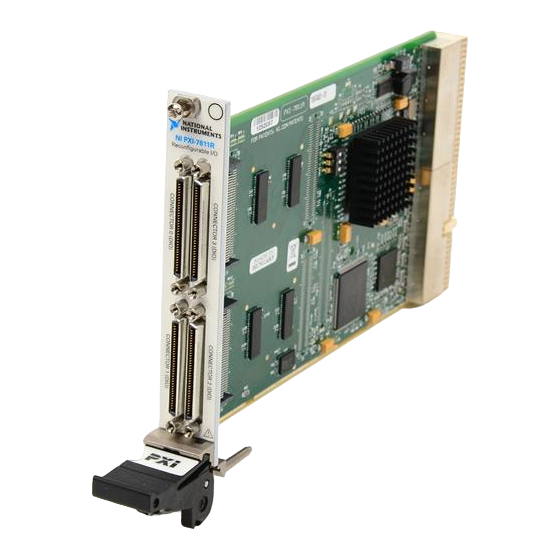
National Instruments Network Device NI PXI-7811R Quick Start Manual
National instruments network device quick start guide
Hide thumbs
Also See for Network Device NI PXI-7811R:
- User manual (75 pages) ,
- Note to users (11 pages) ,
- User manual (71 pages)
Table of Contents
Advertisement
Quick Links
Getting Started with the
NI PXI-7811R
Introduction
Note
If you are using LabVIEW but not the LabVIEW FPGA Module, you can create VIs
that run in LabVIEW to control existing FPGA VIs, but you cannot create new FPGA VIs.
This document explains how to set up the National Instruments PXI-7811R
device.
The PXI-7811R is an R Series reconfigurable I/O (RIO) device with
160 digital I/O (DIO) lines.
Traditional digital I/O devices have a fixed functionality provided by an
application-specific integrated circuit (ASIC), but the PXI-7811R has a
field-programmable gate array (FPGA) that allows you to define device
functionality and timing.
You can use the LabVIEW FPGA Module to graphically design the
PXI-7811R timing and functionality without having to learn a low-level
programming language or a hardware description language (HDL)
traditionally used for FPGA design. With the LabVIEW FPGA Module,
you create or download a custom virtual instrument (VI) to the FPGA.
You can reconfigure the PXI-7811R device with a new VI at any time.
You can use the LabVIEW Real-Time Module to communicate and control
the PXI-7811R device while performing additional tasks, such as real-time
floating-point processing and data logging.
The PXI-7811R device has Flash memory that you can use to store VIs.
You can configure VIs to load to the FPGA and to run when the device
powers up.
Advertisement
Table of Contents

Summary of Contents for National Instruments Network Device NI PXI-7811R
- Page 1 Getting Started with the NI PXI-7811R This document explains how to set up the National Instruments PXI-7811R device. Introduction The PXI-7811R is an R Series reconfigurable I/O (RIO) device with 160 digital I/O (DIO) lines. Traditional digital I/O devices have a fixed functionality provided by an...
-
Page 2: Required Items
Required Items This section provides lists of the items necessary for getting started using the PXI-7811R with Windows 2000/XP and the LabVIEW Real-Time Module. Documentation The NI PXI-7811R User Manual describes the electrical and mechanical aspects of the PXI-7811R device and contains information about device operation and programming. -
Page 3: Installing Software
You must install LabVIEW 7.0 or later and the LabVIEW modules you will be using with the NI 7811R before installing the NI-RIO device drivers. For LabVIEW installation instructions, refer to the LabVIEW Release Notes. © National Instruments Corporation – LabVIEW FPGA Module 1.1 or later—required to develop custom FPGA VIs for the PXI-7811R device –... -
Page 4: Installing Hardware
Installing NI-RIO Device Drivers Complete the following steps to install the NI-RIO device drivers that are included with the PXI-7811R device. If you are using LabVIEW, complete the installation instructions in the Real-Time Module for ETS, and the LabVIEW FPGA Module before installing the NI-RIO device drivers. -
Page 5: Installation
Figure 1 shows the I/O connector locations for the PXI-7811R. The I/O connectors are numbered starting at zero. © National Instruments Corporation Installing Software Power off and unplug the PXI or CompactPCI chassis. Make sure there are no lit LEDs on the chassis. Wait for any lit LEDs to go out before continuing the installation. - Page 6 NI PXI-7811R Reconfigurable I/O Figure 1. PXI-7811R Connector Locations Getting Started with the NI 7811R ni.com...
-
Page 7: Cabling Options
NI 7811R User Manual. Cabling Options Accessing the signals on the I/O connectors requires at least one cable and one signal accessory. Table 1 summarizes the National Instruments cables available for use with the NI 7811R device. © National Instruments Corporation... -
Page 8: Documentation Resources
CompactRIO™, LabVIEW™, MXI™, National Instruments™, NI™, ni.com™, and NI-VISA™ are trademarks of National Instruments Corporation. Product and company names mentioned herein are trademarks or trade names of their respective companies. For patents covering National Instruments products, refer to the appropriate location: Help»Patents in your software, the patents.txt file on your CD, or ni.com/patents.







